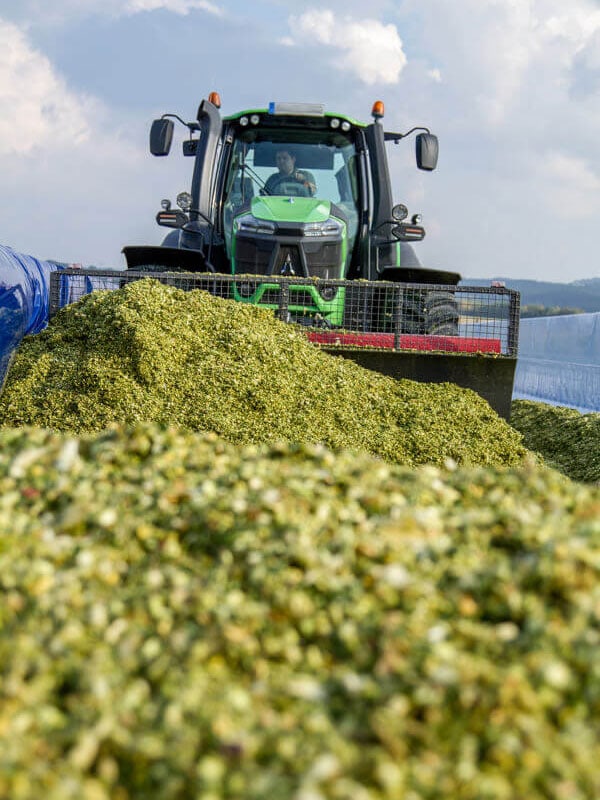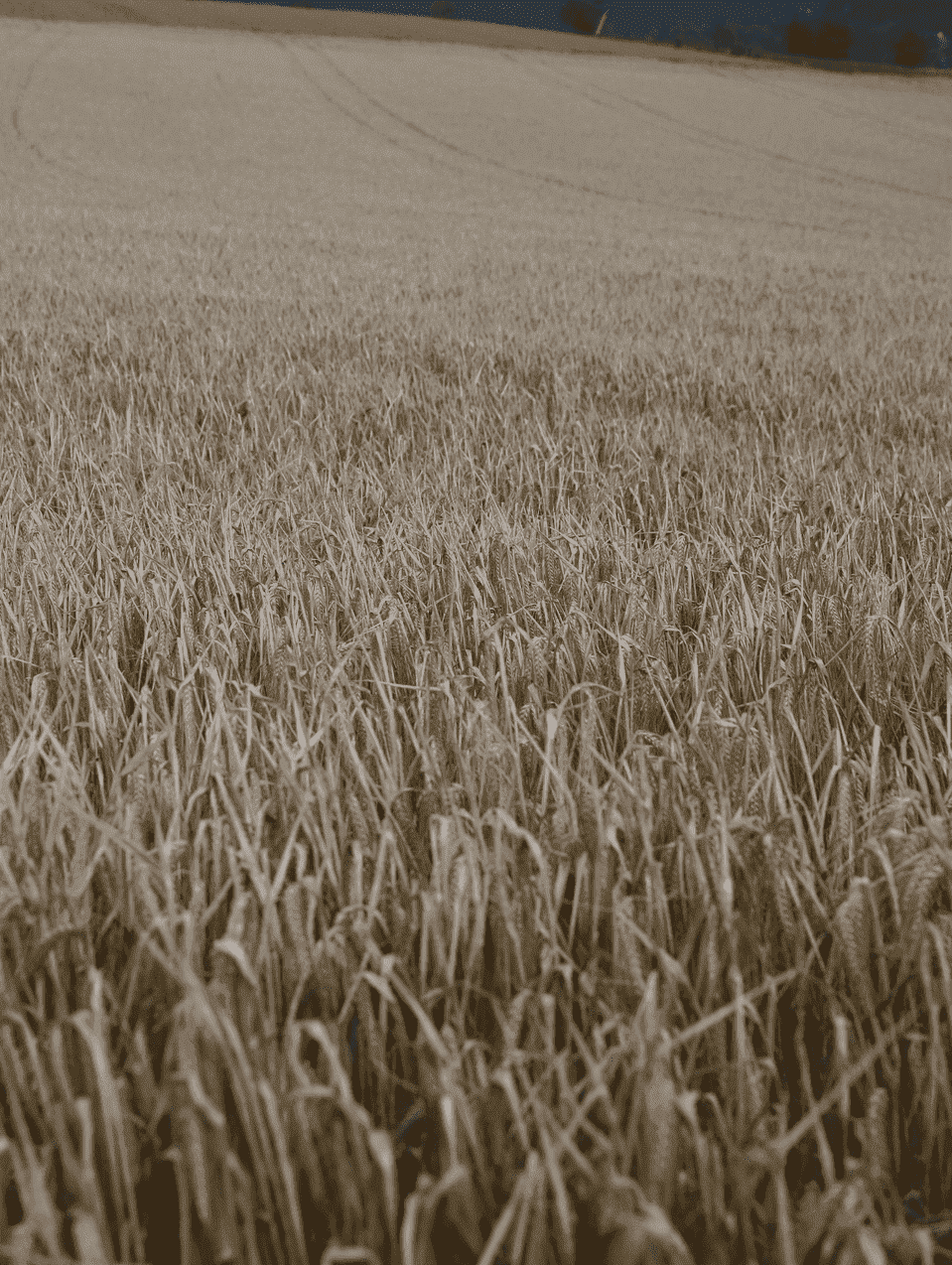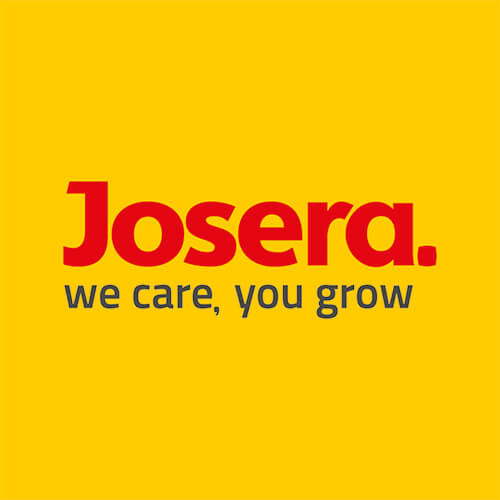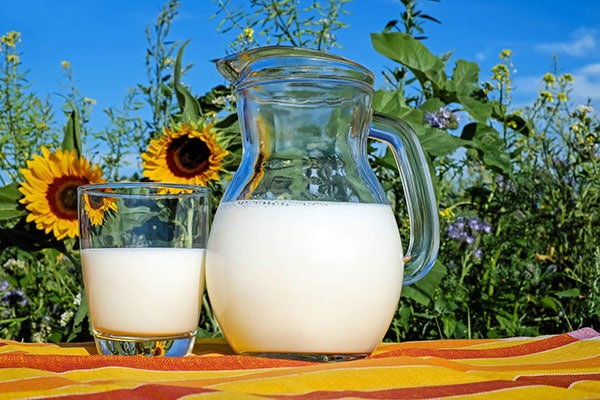In regional terms, a prolonged drought has led to high yield losses in corn and grassland in the recent years. For silage corn, the result was crops with no cobs or poor cob development. Although this year’s spring rain was able to stave off the worst, it was far from enough to replenish the reserves that had been almost depleted by the previous two years.
It is now important for affected companies to consider a timetable for the next few months at an early stage. A well thought-out feed plan must be drawn up in order to react in time to the feed shortage, to switch to potential alternatives and to use the available feed efficiently.
Start with staple feed management!
Enhance the value of existing staple feed
Now is the time when it is of utmost importance to keep the quality of the staple feed high. Wherever possible, no risk should be taken in following areas in particular: It is advisable to re-compact the silo once again and always use suitable silage inoculants to prevent spoilage and reduction in quality. Make sure to check again that the cover is really tight. There is nothing more annoying than diminishing quality of the staple feed in times of feed shortage. It must also be taken into account that the fermentation process takes considerably longer, especially if it is high in dry matter, as is often the case during drought. Do not risk losses by opening the silos too early! With >35% DM, the silage needs at least eight, but more likely 12 weeks to complete the fermentation process.
Get the most out of your staple feed through optimal management, because this is where you can reduce the costs of purchasing additional supplies.
Make your forage last longer by ….
… partial replacement
For instance, grass silage can be saved in the feed of dry cows and the offspring. Here, cereals, straw and soya/rapeseed meal should be used as substitutes, the entire grass silage portion can be replaced in the case of dry cows, and possibly only half in the case of the offspring. This means that the early lactators, the transit group and the feeders as a whole have considerably more staple feed available.
… supplementing it with straw
Straw can also be used to stretch the forage. However, only excellent short-cut straw (length between 3 and 5 cm) with no mould and no inorganic admixtures, such as sand, should be used, otherwise it will be discarded. This supplement ensures a higher structural content of the ration and can partially compensate for increased concentrate feed allowances to prevent rumen acidosis caused by concentrate.

? A word of caution: Too high structural content can reduce the rate of passage and thus also the feed intake. Also, supplementing with straw naturally reduces the energy density of the ration, which in turn correlates with the milk yield. This is of particular relevance in the transit group and the early lactating cows. The feeders also get along worse with energy-reduced rations. Supplementing with straw is not recommended here, the forage should therefore be better saved for the rearing, mainly in the second year of rearing, and for older milkers. An allowance of up to 4 kg per animal per day is possible here, but the ration must be supplemented with protein and energy-rich additives (cereals, corn, rapeseed extraction meal …) or concentrated feed. Mixing in molasses, molasses chips or glycerine also improves palatability and thus has a positive effect on feed intake. It also prevents the straw portion from being discarded. ?
…supplementing with concentrated feed
As a rule, it is advisable to reserve the best feed for fresh milkers, transit groups and calves up to 6 months old. These animals are the most sensitive to insufficient feed quantity and quality and therefore occupy a special position. Here, no energy savings can be made under any circumstances. The ration should consist of at least 50% forage, even in periods of limited forage availability. A concentrated feed content of less than 50% is not physiological for the rumen and it can lead to rumen acidosis.
However, if 50% concentrate content is already close due to a serious shortage of staple feed, buffering substances can still provide some breathing space. We know from past experience that JOSERA DairyPilot can make an important contribution to healthy rumen function, especially in rations rich in concentrated feed.
If the rations are precarious in terms of structural supply, the animals should at least always have food in the trough.
Ensuring mineral supply
Limited forage quantities and a widely fluctuating quality of feed may make it necessary to check mineral and active ingredients content. Corn-heavy rations, which are often used due to a lack of grass silage, have a significantly lower ß-carotene content than grass-heavy rations. Since an optimal ß-carotene supply is essential for fertility, deficits can occur especially in times of reduced feed intake (Transit phase). Follicles have a memory, which means that fertility problems persist for several weeks after a shortage and the fertilised egg has a lower chance of survival.
The same applies to grass silage with a dry matter content of more than 45%. In both cases, a ß-carotene supplement is recommended until the next pregnancy.
? It is also important to ensure optimised absorption and utilisation of nutrients. In addition to an optimised ration, the use of JOSERA DairyPilot is recommended for more efficient nutrient digestion in the rumen. ?
What other options are available?
More grassland cutting to create more grass silage
If more precipitation falls after the last cut has been made, it may make it possible to extend cutting. It should be noted that the proportion of herbs is likely to be higher than normal, as the grass has been much more affected by the drought.
This additional cut will therefore offer a slightly lower energy forage option. This must be taken into account when planning the ration: The first, high-energy cuts should be reserved for animals in early lactation, the transit phase and the first year of rearing, while the later cuts can be used as staple feed for dry cows and the second year of rearing. Nevertheless, dry matter, cutting height and ash content should also be considered.
However, frequent deep cuts and a higher herb and dry matter content often affect the fermentation process of these late silages. The use of a biological silage inoculant, such as Josilac classic, helps protect the silage from fermentation problems and preserves the nutritional value of a crop that is scarce this year.

Catch crops as feed reserve
Due to the superior feed quality of corn and grass, catch crops have virtually disappeared from the feed menu in recent decades. In times of staple feed shortage, however, it is a good idea to use catch crops as feed again.
There is a choice between summer catch crops such as spring rape, spring turnip, fodder cabbage and sunflowers, which can be used in the same year, and winter catch crops such as winter rape, winter turnip and fodder rye, as well as Italian ryegrass and green rye, which are usually only used after the following winter. For summer catch crops, the sowing date should be between mid-July and the end of August at the latest; from mid-August onwards, winter catch crops can be sown.
In order to increase the amount of feed in the same year, annual ryegrass is recommended as a summer catch crop. With a feed value number of 7, it is known to be highly palatable and produces high dry matter yields. It can be fed fresh as well as ensilaged and can therefore compensate for acute shortages in the same summer/autumn. Together with clover grass this results in an even higher yielding mixture (e.g. Landsberger mixture). To provide for the next year, the hardy Italian ryegrass can alternatively be chosen as a winter catch crop, which is then ready for cutting by the end of April next year, freeing the land for corn cultivation.
The popular Landsberger mix, which is grown as a winter catch crop, can also be used as feed. It is a mixture consisting of half Italian ryegrass and half legumes (crimson clover and winter vetch). In addition to its excellent properties as a soil improver, this mixture is also very productive, tasty and, due to its high protein content, well suited for dairy cow feeding.
Whole plant silage from cereals
In addition to catch crops, whole crop silage also allows more efficient use of the existing capacity. Due to its relatively high fibre content with medium digestibility, this silage can be a good supplement to a grass silage ration. Up to 6 kg DM per cow per day can be fed, a mineral feed supplement is recommended. There are, however, a few more points to consider:
- The ratio between straw and grain is important. More grains means more energy and better ensiling. For instance, this ratio is significantly better for wheat and barley than for rye. All available options should be considered carefully. In order to achieve the highest possible energy content, the plants should also be brought to dough maturity, i.e. about two to three weeks BEFORE the actual threshing date. The target is about 35-45% dry matter at harvest, but if this is not achieved, the energy content will drop significantly due to the increasing raw fibre content (straw).
- However, the presence of grain does not bring any added value either: Grain must be cracked, otherwise it passes through the cattle digestive tract whole and fails to deliver any value. Therefore, grain must be finely shredded, if possible to under 8 mm in size!
- Also silaging is not quite simple. Cereal GPS heats up easily; it must be compacted particularly carefully and covered quickly. Apart from appropriate cracking of the grain (so that enough free starch/sugar is available for fermentation), the use of silage inoculants is also highly recommended here.

Pressed pulp silage – a feed component with side effects
Pressed pulp is a by-product of sugar extraction. As such, it is not only very energy-dense, but also exceptionally tasty. It contains a large proportion of easily digestible carbohydrates (hemicellulose, pectin), which can be quickly made available in the rumen, but do not burden the digestion as much as sugar and pure starch do. However, fresh pressed pulp does not have a long shelf life and should therefore be ensiled quickly.
Pressed pulp silage is ensilaged warm (between 50 and 55°C) and can be fed after 6 to 8 weeks when it has cooled down. Although pressed pulp silage improves digestibility of grass silage and hay, it has a low structural effect, so it must be combined with straw and upgraded with mineral feed. However, it also reduces ammonia emissions through better use of nitrogen: milk urea is lower for the same output. It is suitable, for example, as a corn silage substitute to supplement protein-rich feed (e.g. grass silage). For dairy cattle, a maximum of 4 to 5 kg of dry matter or 20 kg of fresh mass should be used.
Potato pulp – highly digestible energy supplier
Potato pulp is still used rather rarely, but in principle it is well suited for feeding on the dairy farm. It is produced during extraction of potato starch and contains all potato components except the technically extracted potato starch. Its remaining content of highly digestible starch is therefore still high (up to 40%), making it an excellent source of energy. However, its low structural effectiveness must also be compensated for by a straw supplement, and supplementation with mineral feed is also necessary. After that, up to 10kg per animal per day can be fed, where starch content is almost 100% available!
Draff – Tried and tested
Draff is a good supplement to the forage with a dietary effect. These are the solid residues of the malt used in beer production, which are rich in protein and therefore represent a high-quality feed.
Spent grains can be fed fresh, but do not last long. However, it can be easily ensiled either as silage bags or on a base plate at 40 °C. From a temperature of 20 degrees, draff can be fed to livestock after about 4 to 6 weeks. In order to prevent silage effluent losses, dry chips can also be ensiled, just as with wet grass silage. Up to 12kg/animal/day spent grains silage is possible.
What else is there?
There are several other ingredients, which can be used to supplement the feed ration. Citrus and apple pomace and corn gluten can also be added to the ration as energy boosters. Small pieces of sugar beet and carrot pomace are also suitable as feed on the dairy farm.
Sugar beet fragments
During processing of sugar beets, not only the already mentioned pressed pulp is produced, but also so-called sugar beet fragments. This fraction consists mainly of beet fragments and beet leaves. They are also rich in energy, highly digestible and easy to silage.
Apple pomace
Apple pomace is a by-product of apple juice extraction. It offers high palatability and energy density due to the high content of hemicellulose, cellulose and pectins. It also contains about 20% crude fibre and smaller amounts of crude protein.
Carrot pomace
Residues also occur naturally when pressing carrot juice. It is called carrot pomace and is a very good feed: Rich in energy, vitamins, very tasty and with a very high content of carotenoids. 3-4kg/cow/day cover the entire carotene requirement, which has a positive effect on fertility. Due to its high sugar content, carrot pomace can also be ensiled very well. Tip: To prevent surface shrinkage, sprinkling the surface with salt is recommended
Corn gluten and corn gluten feed
Both feeds are by-products of starch and alcohol extraction from corn and can be used as protein supplements. However, they are different, as corn gluten contains mainly the gluten substance of the grains, while corn gluten feed contains all the by-products, including hulls, gluten, water and endosperm. Therefore, corn gluten naturally contains significantly more crude protein, the proportion is more than twice as high as in corn gluten feed, the same applies to rumen-stable protein. In contrast, corn gluten feed contains more starch and sugar. Corn gluten feed also contains considerably more crude fibre and can also be ensilaged easily. However, to ensure a good amino acid balance, it should be supplemented with soybean meal. Both feeds are rich in vitamin A and carotenoids, which can have a positive effect on fertility, especially in times of feed shortage, see above.
Potato tubers
Overproduction of table potatoes can also be added to the beef ration. They are rich in starch and sugar, but are not easy to manage. On the one hand, mineral supply must always be balanced. On the other hand, quality has to be closely monitored. More soil can be potentially introduced into the feed that is safe for feeding cattle. Soil dissipates best when it is completely dry, but sprouting must also be prevented, because sprouted potatoes contain solanine, a poisonous substance that can cause massive health damage – so it is best to store them in a dark airy space (under a loose silage film). Temperatures which are too warm and too cold (frost) also affect storage life and, although ensilaging is entirely possible, it should be noted that large quantities of fermentation juices escape. This can be avoided by layering silage with corn, if corn is adequately dry (>32% DM).
Special conditions due to Covid-19
It is advisable to monitor, if larger quantities of by-products from the food industry accumulated in your region in the coming months due to the coronavirus crisis. These could be an additional feed supplement, but should be carefully examined to see whether they are suitable for feeding.
The last resort: Reduce the number of animals
The last resort is to cull. Above all, overcrowding must be avoided. Here it may be advisable to introduce culls at all ages. The only young animals that should remain in the herd are those required for recovery of the herd, old and slaughter cows that are to be slaughtered anyway must leave the farm promptly. Upcoming recovery measures can be brought forward to provide relief more quickly.
Conclusion
Location factors, costs and product availability will determine which strategy is right for your farm. A well thought-out ration calculation is helpful in any case and can save a lot of money.
The advantage of biological silage inoculants in securing the farm’s own staple feed supply is also undisputed. These can minimize the loss of mass and energy in silages and decisively mitigate abnormal and secondary fermentation.
Usability of the existing staple feed, added supplementary feed and mineral feed is improved by the use of JOSERA DairyPilot .

You might be interested in the following contents:
How does feed influence the milk ingredients?
Milk is still one of the world’s staple foods. The development of milk production in Germany reflects the enormous performance potential of herds on farms.
JOSERA DairyPilot–increase the milk yield of your herd!
Is your operative goal to increase the performance of your herd? Or are the health and resilience of your herd important to you? Then read more about JOSERA DairyPilot!






 (1 Votes, average: 5.00 von 5)
(1 Votes, average: 5.00 von 5)
